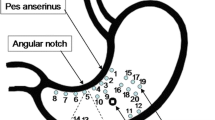Background: This study was initiated 3 years ago when antral gastric electric stimulation was first used successfully to reduce free feeding in swine. Methods: Three swine weighing 45 kg each were implanted with one subserosal bipolar electrode, positioned in the antrum, close to the pylorus, at the anterior side of the lesser gastric curvature. Results: During 4 h of kethamine anaesthesia we paced the stomach by various patterns of electrical stimulation and obtained both forward and backward peristalsis, as well as gastric paresis. Conclusion: Variations in antral electrical stimulation produce characteristic patterns of forward and reverse peristalsis.
Similar content being viewed by others
Author information
Authors and Affiliations
Rights and permissions
About this article
Cite this article
Cigaina, V., Pinato, G.P., Rigo, V. et al. Gastric Peristalsis Control by Mono Situ Electrical Stimulation: a Preliminary Study. OBES SURG 6, 247–249 (1996). https://doi.org/10.1381/096089296765556845
Published:
Issue Date:
DOI: https://doi.org/10.1381/096089296765556845




